Video Analysis: Analyzing Therapeutic Communication in Healthcare
VerifiedAdded on 2021/06/17
|7
|1795
|155
Report
AI Summary
This report presents a detailed analysis of a video depicting a nurse-patient interaction, focusing on the effectiveness of communication techniques employed by the nurse. The analysis identifies several critical errors, including inappropriate body posture, casual approach, unprofessional behavior such as using the patient's incorrect name and using a mobile phone during the interaction, lack of empathy, and failure to address the patient's concerns with sensitivity. The report emphasizes the importance of establishing therapeutic communication through attentive listening, respectful conduct, and empathetic responses. It underscores the need for nurses to demonstrate genuine care, maintain professional boundaries, and prioritize the patient's comfort and well-being. The analysis also references several academic sources to support the findings and recommendations, highlighting the impact of effective communication on patient outcomes and overall healthcare quality.
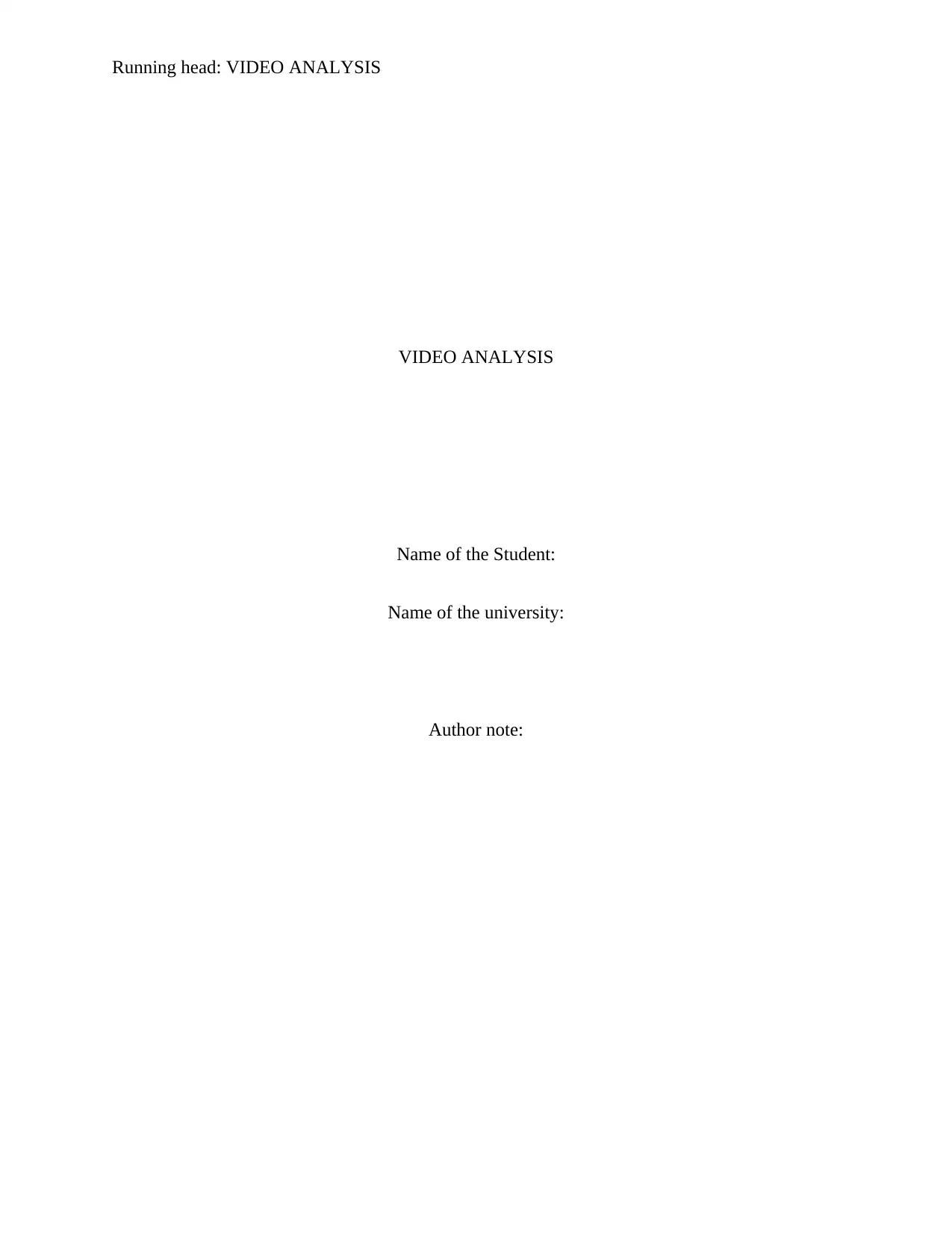
Running head: VIDEO ANALYSIS
VIDEO ANALYSIS
Name of the Student:
Name of the university:
Author note:
VIDEO ANALYSIS
Name of the Student:
Name of the university:
Author note:
Paraphrase This Document
Need a fresh take? Get an instant paraphrase of this document with our AI Paraphraser
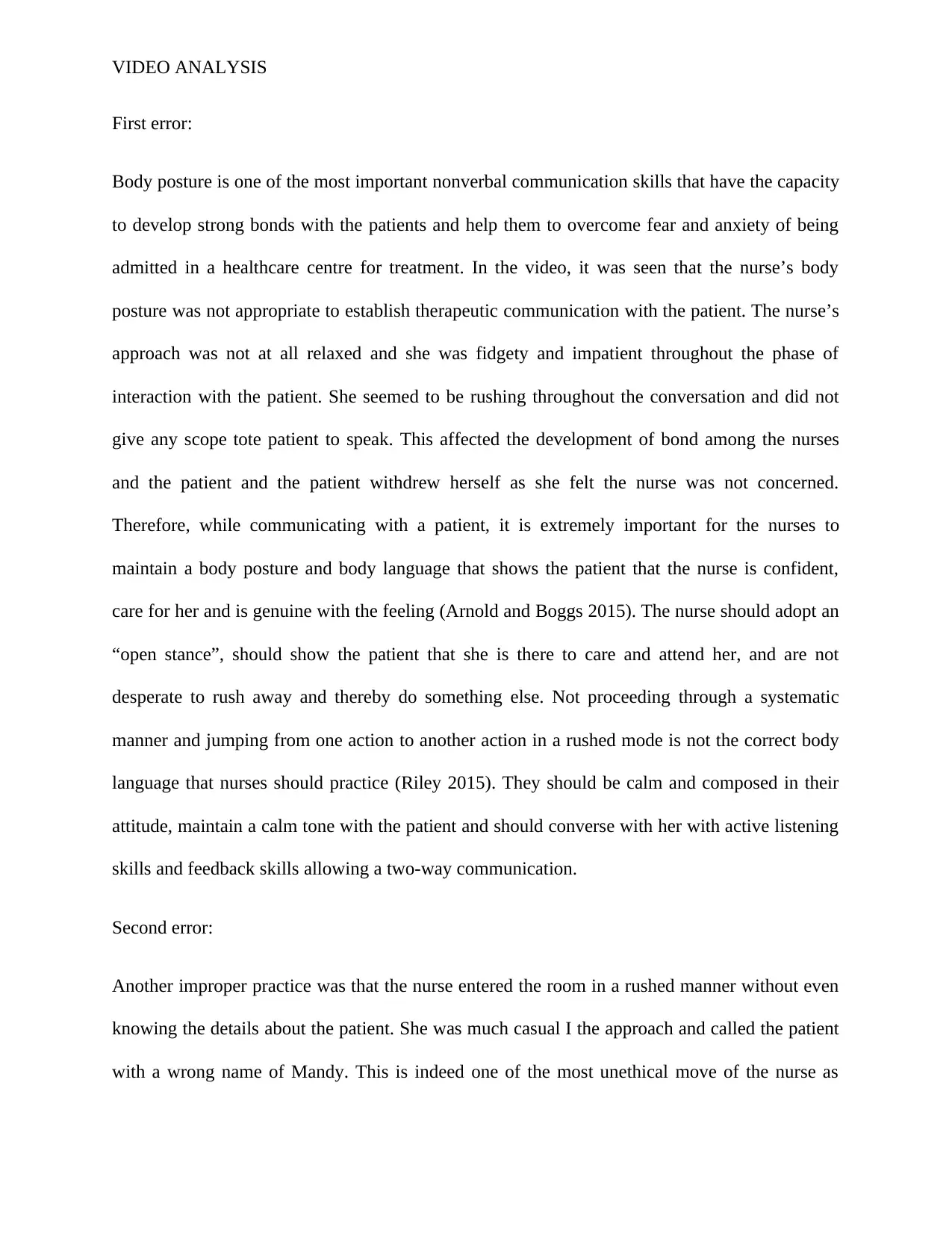
VIDEO ANALYSIS
First error:
Body posture is one of the most important nonverbal communication skills that have the capacity
to develop strong bonds with the patients and help them to overcome fear and anxiety of being
admitted in a healthcare centre for treatment. In the video, it was seen that the nurse’s body
posture was not appropriate to establish therapeutic communication with the patient. The nurse’s
approach was not at all relaxed and she was fidgety and impatient throughout the phase of
interaction with the patient. She seemed to be rushing throughout the conversation and did not
give any scope tote patient to speak. This affected the development of bond among the nurses
and the patient and the patient withdrew herself as she felt the nurse was not concerned.
Therefore, while communicating with a patient, it is extremely important for the nurses to
maintain a body posture and body language that shows the patient that the nurse is confident,
care for her and is genuine with the feeling (Arnold and Boggs 2015). The nurse should adopt an
“open stance”, should show the patient that she is there to care and attend her, and are not
desperate to rush away and thereby do something else. Not proceeding through a systematic
manner and jumping from one action to another action in a rushed mode is not the correct body
language that nurses should practice (Riley 2015). They should be calm and composed in their
attitude, maintain a calm tone with the patient and should converse with her with active listening
skills and feedback skills allowing a two-way communication.
Second error:
Another improper practice was that the nurse entered the room in a rushed manner without even
knowing the details about the patient. She was much casual I the approach and called the patient
with a wrong name of Mandy. This is indeed one of the most unethical move of the nurse as
First error:
Body posture is one of the most important nonverbal communication skills that have the capacity
to develop strong bonds with the patients and help them to overcome fear and anxiety of being
admitted in a healthcare centre for treatment. In the video, it was seen that the nurse’s body
posture was not appropriate to establish therapeutic communication with the patient. The nurse’s
approach was not at all relaxed and she was fidgety and impatient throughout the phase of
interaction with the patient. She seemed to be rushing throughout the conversation and did not
give any scope tote patient to speak. This affected the development of bond among the nurses
and the patient and the patient withdrew herself as she felt the nurse was not concerned.
Therefore, while communicating with a patient, it is extremely important for the nurses to
maintain a body posture and body language that shows the patient that the nurse is confident,
care for her and is genuine with the feeling (Arnold and Boggs 2015). The nurse should adopt an
“open stance”, should show the patient that she is there to care and attend her, and are not
desperate to rush away and thereby do something else. Not proceeding through a systematic
manner and jumping from one action to another action in a rushed mode is not the correct body
language that nurses should practice (Riley 2015). They should be calm and composed in their
attitude, maintain a calm tone with the patient and should converse with her with active listening
skills and feedback skills allowing a two-way communication.
Second error:
Another improper practice was that the nurse entered the room in a rushed manner without even
knowing the details about the patient. She was much casual I the approach and called the patient
with a wrong name of Mandy. This is indeed one of the most unethical move of the nurse as

VIDEO ANALYSIS
calling patients by wrong name may has the potential to affect the dignity and autonomy of the
nurses. The nurse in the video not only called the patient by the wrong name but also repeated
the name of the patient in short form after the patient had clarified her name. Patients in such
situation become disappointed or upset as they feel that the nurse do not respect them enough
and are not at all careful about their health. The patient feels depressed with this casual attitude
of the nurse and feels that she is powerless and therefore the nurse is not paying importance to
autonomy and dignity of the patient. Such casual attitudes and careless approach of entering the
patient cubicle even without knowing the name of the patient affects dignity and autonomy and
is therefore prevents effective therapeutic communication. Therefore, a nurse should always
prepare herself in ways by which she can establish effective communication with the patient. She
should know about the name of the patient, her preferences of different kinds, her culture and
others (Webster, 2014). Even if the information is not recorded, the nursing professionals should
question the patient by providing enough respect and showing genuine concern to know about
them, their health and their issues. This would make the patient feel that she is in safe hands and
this would help them to communicate freely and openly with the nurses (Maclean et al. 2017).
Third error:
During the conversation with the patient, the professional was seen to sit on the bed all of
a sudden which was not a correct approach and expression of body language. She was seen to be
distractive in the communication procedure, even took out her mobile phone, and started reading
text in the midst of the conversation. She went out of the limit of professional conduct and even
showed the text or picture of her person friends to her irrespective of the wish of the patient to
see them. Such an activity while communicating with the patient makes the patient feel that the
nursing professionals is not interested in caring as well as engaging with the patient. She might
calling patients by wrong name may has the potential to affect the dignity and autonomy of the
nurses. The nurse in the video not only called the patient by the wrong name but also repeated
the name of the patient in short form after the patient had clarified her name. Patients in such
situation become disappointed or upset as they feel that the nurse do not respect them enough
and are not at all careful about their health. The patient feels depressed with this casual attitude
of the nurse and feels that she is powerless and therefore the nurse is not paying importance to
autonomy and dignity of the patient. Such casual attitudes and careless approach of entering the
patient cubicle even without knowing the name of the patient affects dignity and autonomy and
is therefore prevents effective therapeutic communication. Therefore, a nurse should always
prepare herself in ways by which she can establish effective communication with the patient. She
should know about the name of the patient, her preferences of different kinds, her culture and
others (Webster, 2014). Even if the information is not recorded, the nursing professionals should
question the patient by providing enough respect and showing genuine concern to know about
them, their health and their issues. This would make the patient feel that she is in safe hands and
this would help them to communicate freely and openly with the nurses (Maclean et al. 2017).
Third error:
During the conversation with the patient, the professional was seen to sit on the bed all of
a sudden which was not a correct approach and expression of body language. She was seen to be
distractive in the communication procedure, even took out her mobile phone, and started reading
text in the midst of the conversation. She went out of the limit of professional conduct and even
showed the text or picture of her person friends to her irrespective of the wish of the patient to
see them. Such an activity while communicating with the patient makes the patient feel that the
nursing professionals is not interested in caring as well as engaging with the patient. She might
⊘ This is a preview!⊘
Do you want full access?
Subscribe today to unlock all pages.

Trusted by 1+ million students worldwide
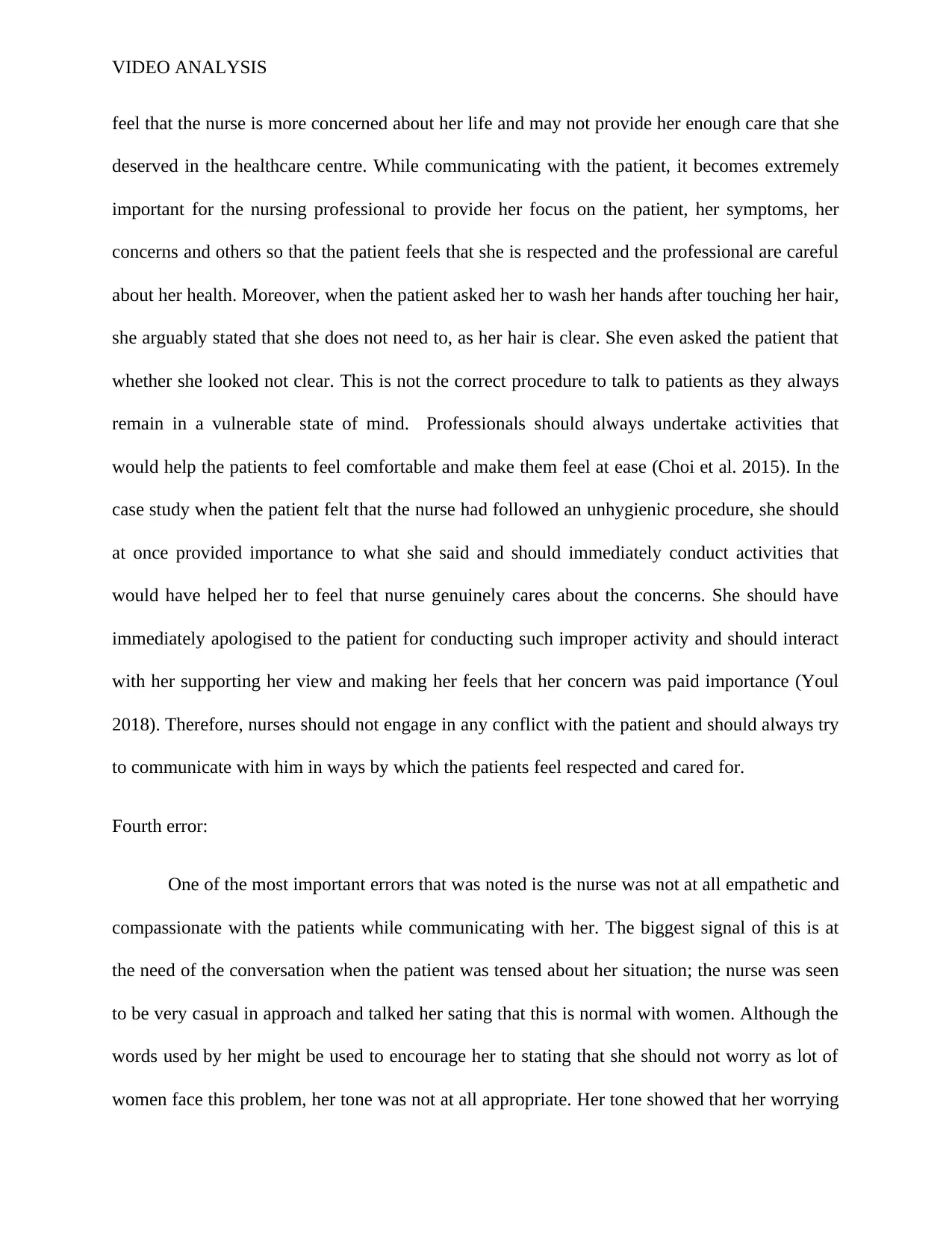
VIDEO ANALYSIS
feel that the nurse is more concerned about her life and may not provide her enough care that she
deserved in the healthcare centre. While communicating with the patient, it becomes extremely
important for the nursing professional to provide her focus on the patient, her symptoms, her
concerns and others so that the patient feels that she is respected and the professional are careful
about her health. Moreover, when the patient asked her to wash her hands after touching her hair,
she arguably stated that she does not need to, as her hair is clear. She even asked the patient that
whether she looked not clear. This is not the correct procedure to talk to patients as they always
remain in a vulnerable state of mind. Professionals should always undertake activities that
would help the patients to feel comfortable and make them feel at ease (Choi et al. 2015). In the
case study when the patient felt that the nurse had followed an unhygienic procedure, she should
at once provided importance to what she said and should immediately conduct activities that
would have helped her to feel that nurse genuinely cares about the concerns. She should have
immediately apologised to the patient for conducting such improper activity and should interact
with her supporting her view and making her feels that her concern was paid importance (Youl
2018). Therefore, nurses should not engage in any conflict with the patient and should always try
to communicate with him in ways by which the patients feel respected and cared for.
Fourth error:
One of the most important errors that was noted is the nurse was not at all empathetic and
compassionate with the patients while communicating with her. The biggest signal of this is at
the need of the conversation when the patient was tensed about her situation; the nurse was seen
to be very casual in approach and talked her sating that this is normal with women. Although the
words used by her might be used to encourage her to stating that she should not worry as lot of
women face this problem, her tone was not at all appropriate. Her tone showed that her worrying
feel that the nurse is more concerned about her life and may not provide her enough care that she
deserved in the healthcare centre. While communicating with the patient, it becomes extremely
important for the nursing professional to provide her focus on the patient, her symptoms, her
concerns and others so that the patient feels that she is respected and the professional are careful
about her health. Moreover, when the patient asked her to wash her hands after touching her hair,
she arguably stated that she does not need to, as her hair is clear. She even asked the patient that
whether she looked not clear. This is not the correct procedure to talk to patients as they always
remain in a vulnerable state of mind. Professionals should always undertake activities that
would help the patients to feel comfortable and make them feel at ease (Choi et al. 2015). In the
case study when the patient felt that the nurse had followed an unhygienic procedure, she should
at once provided importance to what she said and should immediately conduct activities that
would have helped her to feel that nurse genuinely cares about the concerns. She should have
immediately apologised to the patient for conducting such improper activity and should interact
with her supporting her view and making her feels that her concern was paid importance (Youl
2018). Therefore, nurses should not engage in any conflict with the patient and should always try
to communicate with him in ways by which the patients feel respected and cared for.
Fourth error:
One of the most important errors that was noted is the nurse was not at all empathetic and
compassionate with the patients while communicating with her. The biggest signal of this is at
the need of the conversation when the patient was tensed about her situation; the nurse was seen
to be very casual in approach and talked her sating that this is normal with women. Although the
words used by her might be used to encourage her to stating that she should not worry as lot of
women face this problem, her tone was not at all appropriate. Her tone showed that her worrying
Paraphrase This Document
Need a fresh take? Get an instant paraphrase of this document with our AI Paraphraser
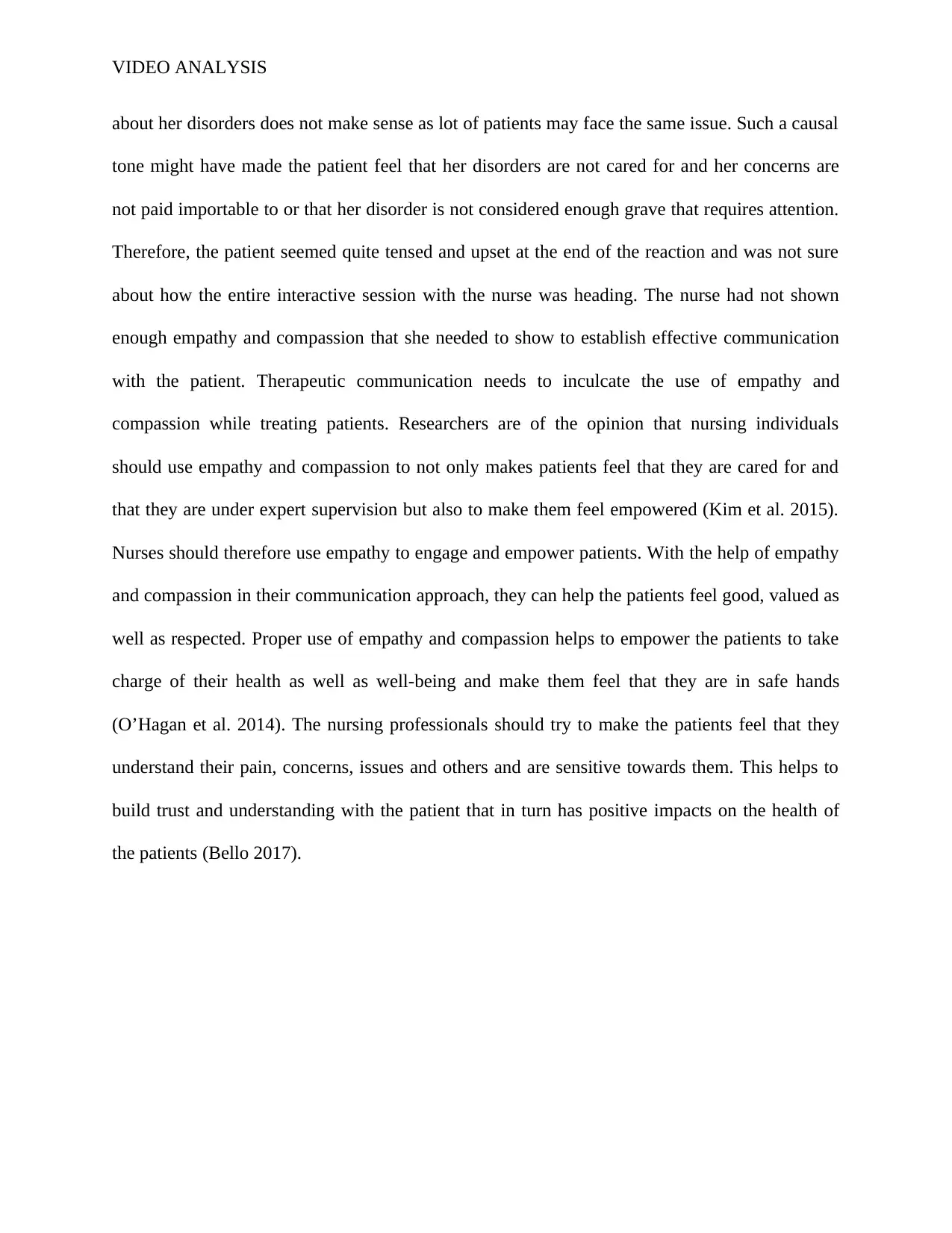
VIDEO ANALYSIS
about her disorders does not make sense as lot of patients may face the same issue. Such a causal
tone might have made the patient feel that her disorders are not cared for and her concerns are
not paid importable to or that her disorder is not considered enough grave that requires attention.
Therefore, the patient seemed quite tensed and upset at the end of the reaction and was not sure
about how the entire interactive session with the nurse was heading. The nurse had not shown
enough empathy and compassion that she needed to show to establish effective communication
with the patient. Therapeutic communication needs to inculcate the use of empathy and
compassion while treating patients. Researchers are of the opinion that nursing individuals
should use empathy and compassion to not only makes patients feel that they are cared for and
that they are under expert supervision but also to make them feel empowered (Kim et al. 2015).
Nurses should therefore use empathy to engage and empower patients. With the help of empathy
and compassion in their communication approach, they can help the patients feel good, valued as
well as respected. Proper use of empathy and compassion helps to empower the patients to take
charge of their health as well as well-being and make them feel that they are in safe hands
(O’Hagan et al. 2014). The nursing professionals should try to make the patients feel that they
understand their pain, concerns, issues and others and are sensitive towards them. This helps to
build trust and understanding with the patient that in turn has positive impacts on the health of
the patients (Bello 2017).
about her disorders does not make sense as lot of patients may face the same issue. Such a causal
tone might have made the patient feel that her disorders are not cared for and her concerns are
not paid importable to or that her disorder is not considered enough grave that requires attention.
Therefore, the patient seemed quite tensed and upset at the end of the reaction and was not sure
about how the entire interactive session with the nurse was heading. The nurse had not shown
enough empathy and compassion that she needed to show to establish effective communication
with the patient. Therapeutic communication needs to inculcate the use of empathy and
compassion while treating patients. Researchers are of the opinion that nursing individuals
should use empathy and compassion to not only makes patients feel that they are cared for and
that they are under expert supervision but also to make them feel empowered (Kim et al. 2015).
Nurses should therefore use empathy to engage and empower patients. With the help of empathy
and compassion in their communication approach, they can help the patients feel good, valued as
well as respected. Proper use of empathy and compassion helps to empower the patients to take
charge of their health as well as well-being and make them feel that they are in safe hands
(O’Hagan et al. 2014). The nursing professionals should try to make the patients feel that they
understand their pain, concerns, issues and others and are sensitive towards them. This helps to
build trust and understanding with the patient that in turn has positive impacts on the health of
the patients (Bello 2017).
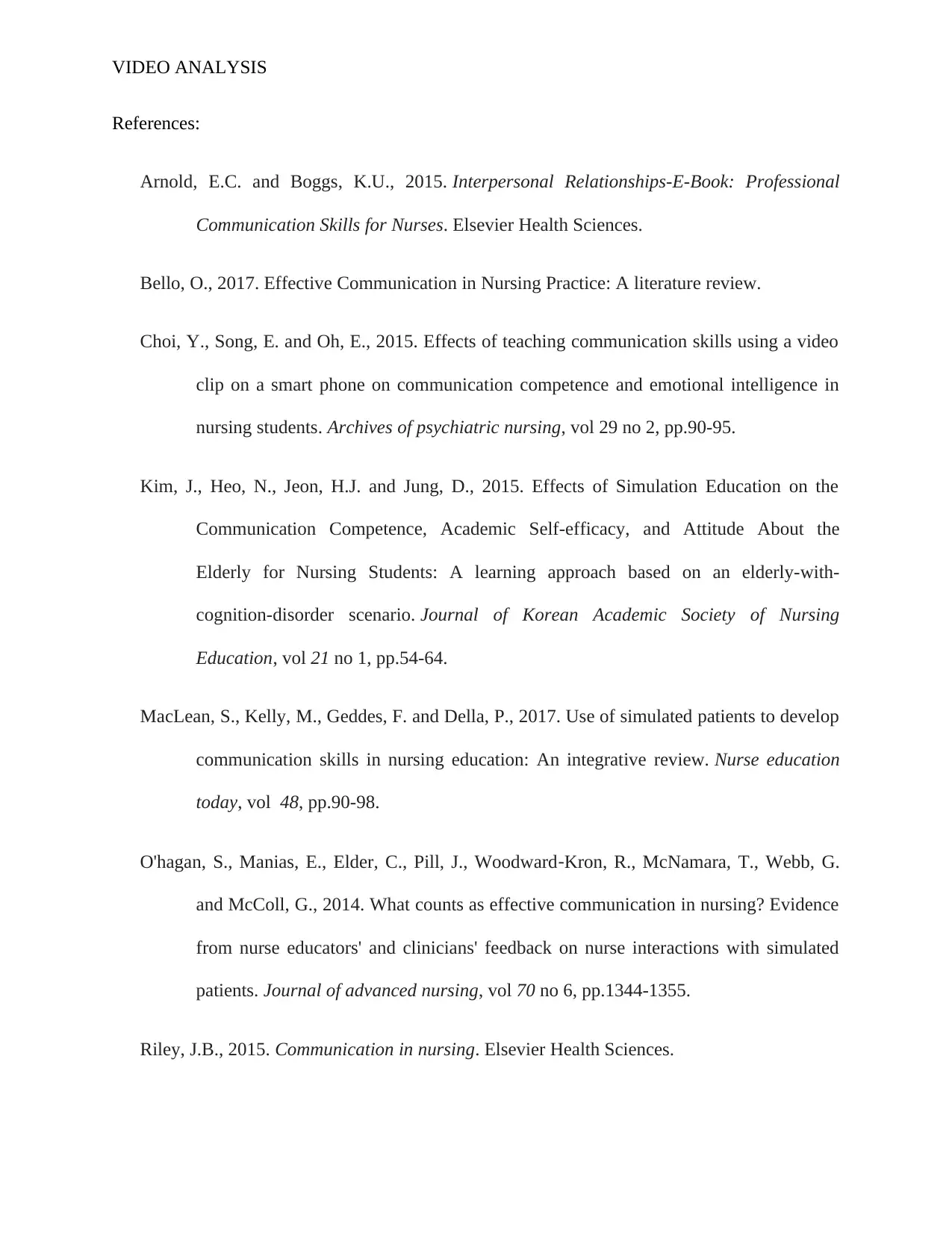
VIDEO ANALYSIS
References:
Arnold, E.C. and Boggs, K.U., 2015. Interpersonal Relationships-E-Book: Professional
Communication Skills for Nurses. Elsevier Health Sciences.
Bello, O., 2017. Effective Communication in Nursing Practice: A literature review.
Choi, Y., Song, E. and Oh, E., 2015. Effects of teaching communication skills using a video
clip on a smart phone on communication competence and emotional intelligence in
nursing students. Archives of psychiatric nursing, vol 29 no 2, pp.90-95.
Kim, J., Heo, N., Jeon, H.J. and Jung, D., 2015. Effects of Simulation Education on the
Communication Competence, Academic Self-efficacy, and Attitude About the
Elderly for Nursing Students: A learning approach based on an elderly-with-
cognition-disorder scenario. Journal of Korean Academic Society of Nursing
Education, vol 21 no 1, pp.54-64.
MacLean, S., Kelly, M., Geddes, F. and Della, P., 2017. Use of simulated patients to develop
communication skills in nursing education: An integrative review. Nurse education
today, vol 48, pp.90-98.
O'hagan, S., Manias, E., Elder, C., Pill, J., Woodward‐Kron, R., McNamara, T., Webb, G.
and McColl, G., 2014. What counts as effective communication in nursing? Evidence
from nurse educators' and clinicians' feedback on nurse interactions with simulated
patients. Journal of advanced nursing, vol 70 no 6, pp.1344-1355.
Riley, J.B., 2015. Communication in nursing. Elsevier Health Sciences.
References:
Arnold, E.C. and Boggs, K.U., 2015. Interpersonal Relationships-E-Book: Professional
Communication Skills for Nurses. Elsevier Health Sciences.
Bello, O., 2017. Effective Communication in Nursing Practice: A literature review.
Choi, Y., Song, E. and Oh, E., 2015. Effects of teaching communication skills using a video
clip on a smart phone on communication competence and emotional intelligence in
nursing students. Archives of psychiatric nursing, vol 29 no 2, pp.90-95.
Kim, J., Heo, N., Jeon, H.J. and Jung, D., 2015. Effects of Simulation Education on the
Communication Competence, Academic Self-efficacy, and Attitude About the
Elderly for Nursing Students: A learning approach based on an elderly-with-
cognition-disorder scenario. Journal of Korean Academic Society of Nursing
Education, vol 21 no 1, pp.54-64.
MacLean, S., Kelly, M., Geddes, F. and Della, P., 2017. Use of simulated patients to develop
communication skills in nursing education: An integrative review. Nurse education
today, vol 48, pp.90-98.
O'hagan, S., Manias, E., Elder, C., Pill, J., Woodward‐Kron, R., McNamara, T., Webb, G.
and McColl, G., 2014. What counts as effective communication in nursing? Evidence
from nurse educators' and clinicians' feedback on nurse interactions with simulated
patients. Journal of advanced nursing, vol 70 no 6, pp.1344-1355.
Riley, J.B., 2015. Communication in nursing. Elsevier Health Sciences.
⊘ This is a preview!⊘
Do you want full access?
Subscribe today to unlock all pages.

Trusted by 1+ million students worldwide
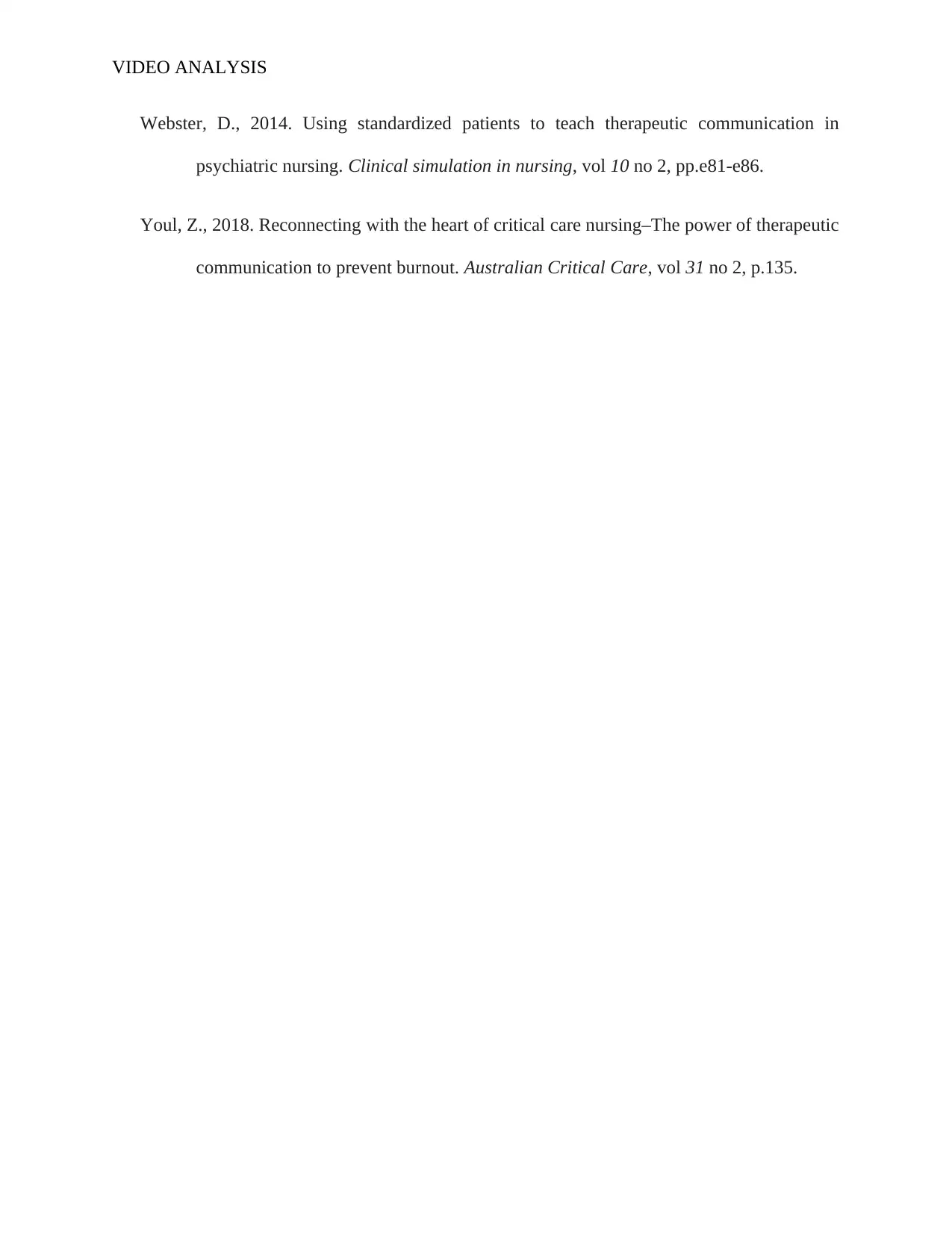
VIDEO ANALYSIS
Webster, D., 2014. Using standardized patients to teach therapeutic communication in
psychiatric nursing. Clinical simulation in nursing, vol 10 no 2, pp.e81-e86.
Youl, Z., 2018. Reconnecting with the heart of critical care nursing–The power of therapeutic
communication to prevent burnout. Australian Critical Care, vol 31 no 2, p.135.
Webster, D., 2014. Using standardized patients to teach therapeutic communication in
psychiatric nursing. Clinical simulation in nursing, vol 10 no 2, pp.e81-e86.
Youl, Z., 2018. Reconnecting with the heart of critical care nursing–The power of therapeutic
communication to prevent burnout. Australian Critical Care, vol 31 no 2, p.135.
1 out of 7
Related Documents
Your All-in-One AI-Powered Toolkit for Academic Success.
+13062052269
info@desklib.com
Available 24*7 on WhatsApp / Email
![[object Object]](/_next/static/media/star-bottom.7253800d.svg)
Unlock your academic potential
Copyright © 2020–2025 A2Z Services. All Rights Reserved. Developed and managed by ZUCOL.




